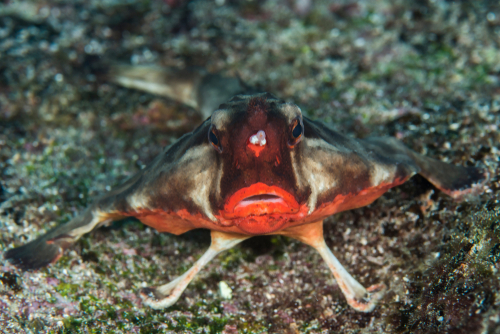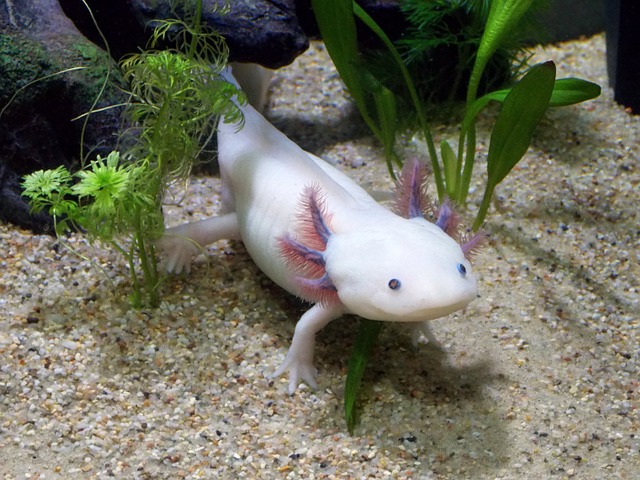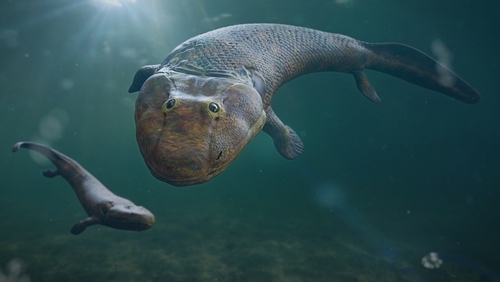When you think of the word “fish,” you’re probably picturing scales, big eyes, and of course, a wide variety of beautiful fins and tails. One thing that rarely springs to mind is a fish that actually has legs!
However, these amazing types of aquatic life are real and popular! In this article, we will show you our list of the most popular fish with four legs, as well as details on their scientific names and even their diets.
Contents
Fish With Four Legs
Check out the list of fish with four legs instead of fins provided below!
- Batfish
- Warty Frogfish
- Axolotl
- Tiktaalik Roseae
- Coelacanth
- Ichthyostega
- Panderichthys
- Eusthenopteron
Let’s take a closer look at these incredible underwater dwellers so that you can see how a fish that actually has four legs lives its life!
Also read:
- Popular Fish That Look Like a Stingray
- Popular Black Fish With White Spots
- Popular Fish That Look Like A Dog
- Popular Fish That Look Like Eels
1. Batfish

- Scientific Name: Ogcocephalidae
- Diet: Carnivore
Coming in at first place on our list is the Batfish! It is an incredibly interesting fish in the anglerfish family. It has been known to waltz around on the seafloor with its legs, making it an awkward swimmer, but a great first place member of our list!
The Batfish is also sometimes called a handfish, a seabat, or a deep-sea batfish. They are found all over the world in oceans of a tropical nature, usually at a depth between 660 and 9840 from the surface…however, some specimens have actually been found at depths of 13,000 feet!
The Batfish is usually structured like a box with a big round or triangular head and a comparatively tiny tail. These fish are around 20 inches long, and like other angler fish, they do also have a small esca or lure of bulbous shape on their heads. Interestingly, the Batfish can retract that lure into a little cavity just above their mouths.
The angler fish we are used to seeing on television has a lure which lights up in dark waters, drawing curious prey in. However, the Batfish, as it crawls around on the seafloor, cannot light it’s lure.
Instead, the lure secrets a little chemical that snails, crabs, shrimp, and small fish love the smell of! The secretion only lasts for around two minutes, but that is usually enough for the Batfish to catch its prey and eat.
2. Warty FrogFish

- Scientific Name: Antennarius Maculatus
- Diet: Carnivore
Coming in at second place on our list is the popular aquarium fish, the Warty FrogFish! This fish is a little more graceful at swimming than the above-mentioned Batfish, but it still has fins which adapt as legs allowing it to crawl lightly along the ocean floor at times.
The Warty FrogFish can get to be around 5.9 inches long, and its body is soft and covered in little spinules. One of the defining traits of the Warty FrogFish, aside from the wart-like protuberances and legs, is its huge mouth.
The huge mouth of the Warty FrogFish allows it to eat the smaller fish it preys upon. Did we say “smaller fish?” Actually, the Warty FrogFish is known for using that huge mouth to eat fish that are almost its same size, which is quite ambitious!
The Warty FrogFish is also popular for its beauty. It is capable of changing color to match its surroundings, but when it is put under an ultraviolet or blue light, it also changes color, emitting a soft biofluorescence of red.
Experts speculate that it has this ability not only to hide from bigger fish, but to communicate with others of its kind.
3. Axolotl

- Scientific Name: Ambystoma Mexicanum
- Diet: Carnivore
Possibly one of the most popular specimens of marine life with legs, the only reason Axolotl’s fame didn’t jettison it straight to the top of our list is that it technically is not a fish!
Axolotls may have gills and remain aquatic for all of their lives, but they are actually considered amphibian members of the salamander group!
Still, experts have been just as fascinated as pet owners are with Axolotls for several reasons, with one of them being: juvenile Axolotls are supposed to grow up and lose its’ fish like gills, living on land…but they do not! Axolotls are very unique because they do not produce a thyrod stimulating hormone.
This thyroid stimulating hormone is responsible for producing a chemical called thyroxine, which is, in turn, what is used for Axolotls and other creatures like it in metamorphosis. Without thyroxine, Axolotls don’t evolve and remain in the water with four legs and gills all their lives.
This is not the only fascinating thing about these popular salamanders! The axolotl has a genome that is around 10 times larger than the human genome, but contains a lot of the same proteins.
This is important because scientists are constantly studying and running tests on Axolotls to discover whether or not their unique healing ability can be used to help sick people.
Axolotls do not scar when they are injured. If they lose whole limbs, not just tails, but arms, legs, and even pieces of their own brain, they can regenerate them over a period of mere months!
This would be unbelievably cool all by itself, but Axolotls have also displayed the ability to accept transplanted limbs or body parts from other axolotls, the same way humans sometimes need a kidney transplant.
The difference is, Axolotls accept these alien organs much more quickly and easily than we do, and can even regain full function of transplanted eyes and brain parts.
Not only are these scientific discoveries awesome, but Axolotls are just plain adorable!
4. Tiktaalik

- Scientific Name: Tiktaalik Roseae
- Diet: Carnivore
The Tiktaalik is a member of the tetrapod family, meaning it was once a fish with four legs! That’s right: Tiktaalik Roseae are extinct now, but paleontologists believe that they once had gills, scales, fins, and even legs.
The Tiktaalik was one of the first examples of aquatic tetrapods found with a long, flat skull like a crocodile’s. It mainly breathed through gills, but had crude organs that were used to breathe air as lungs, too.
The Tiktaalik had several characteristics that were similar to an alligator gar today, including double-rowed teeth, two pairs of nostrils, no anterior dorsal fin, and a long body.
Paleontologists believe that the Tiktaalik was unique because it could move it’s head independently of the rest of its body, unlike fish, and could have moved across small areas of land, too.
Fossils of the Tiktaalik were found in a stream system deposit called the Fram Formation, found close to the Devonian equator.
5. Coelacanth
- Scientific Name: Coelacanth
- Diet: Carnivore
Possibly one of the most interesting fish with legs on our list, the Coelacanth is awesome because it was a fish in the four-legged family, similar to the Tiktaalik, which was also thought to be extinct.
However, even though the Coelacanth’s fossils were found dating back to the Late Cretaceous, they were found still alive in the coast of South Africa in the late 1930s!
Coelacanth is sometimes called a “living fossil” for this reason. They have a unique skeletal structure unlike other fish that matches up with early four-legged fish called ‘lobe-finned fish.’
They are popular for many unique traits, such as the fact that they can move more capable than most fish. Because of their versatile, leg-like fins, they can swim in nearly any direction. They have even been found doing headstands or swimming with their bellies up!
One of the most fun things to observe in these living fossil fish is the fact that they are very polite in behavior toward one another.
In crowded spaces full of other Coelacanths, they remain calm and unbothered, even though other examples of startling a Coelacanth cause it to flee in terror.
This is because several shark bite marks have been found on large Coelacanths, leading to the belief that big predators eat Coelacanths. A Coelacanth will avoid touching other Coelacanths and withdraw, almost as if embarrassed, if they do accidentally bump into one another.
6. Ichthyostega
- Scientific Name: Ichthyostega
- Diet: Carnivore
Another four-legged water dweller that used to exist but is now extinct is the Ichthyostega! Its name means “fish roof” in the Greek language. Scientists were not sure, at first, how to group this animal when its fossils were discovered near Greenland.
It did have legs that were able to bear its weight, as well as lungs. However, it also had gills, and each “foot” was webbed like a fin. Eventually the experts decided that although the extinct tetrapod looks something like a salamander and, indeed, definitely lived in swamps and the shallows, it probably moved on land more like a seal than a salamander.
Ultimately, the Ichthyostega was an interesting prehistoric creature. The first specimens of this creature were found and collected during the Danish Greenland Expedition in 1931, and more were discovered and studied between the years 1933 and the mid-1950s.
The Ichthyostega has a huge ribcage with overlapping ribs, and experts found much in its skeletal structure to compare with modern fish. It was strong enough to actually heave itself out of the water, and paleontologists believe that the animal was not very buoyant on land.
It also would have been an awkward swimmer, unable to move from side to side. The Ichthyostega would not have been much more graceful on land, though, even with it’s legs!
Apparently, experts have found that it did not have enough range of motion in its legs to create an actual four-legged gait, but would have half dragged, half hopped across the land in a “crutching” movement much like seals do today!
7. Panderichthys
- Scientific Name: Panderichthys
- Diet: Carnivore
Another extinct sea creature, the Panerichthys is a part of the srcopterigian genus, which is a big word meaning “lobe-finned fish.” Experts believe it would have lived during the late Devonian period of prehistoric history, and been a part of two different species.
Actually, everything that paleontologists know about this fascinating creature comes from a few fragments of a fossilized snout and a broken lower jaw bone. Named after the paleontologist Christian Heinrich Pander, Panderichthys is one of the first fish considered to have had legs.
It is speculated that pandericthys was around 130 centimeters long at the largest, with a large but flat head featuring a snout and eyes set near the back of the skull, much like an alligator or crocodile.
It probably did not have the dorsal fins that would remind us of modern day fish, but Panderichthys’ lobe fins would have had long, thin rays.
This would have made the panderichthys look much more fishy than the later Ichthyostega, to which it is often compared! It would have had a very limited ability to pull itself out of the water, and it is considered one of the very first fish to be able to breathe air.
It is speculated that while Panderichthys was alive, it probably lived in freshwater basins, staying in the shallows where plenty of fine sandstone and clay would have made the area murky.
8. Eusthenopteron
- Scientific Name: Eusthenopteron
- Diet: Carnivore
Eusthenopteron is our final fish with four legs, though it just barely squeezes in to that category! It was considered to be one of the first evolutionary ancestors to later tetrapods, like our panderichthys or our ichthyostegas!
Around 2,000 specimens of this now-extinct creature’s remains have been found in Miguasha, Quebec, and has been the subject of popular study since the 1940s.
It is considered to be a lobe-finned fish, much like the panderichthys, but unlike that later-known creature, the Eusthenopteron would not have been able to breathe air or move on land at all.
It still had internal nostrils, though, which is one of the unique features of tetrapods, and very sharp teeth. The main reason some depictions of the Eusthenopteron mistakenly show it climbing onto land is because it does, in fact, have four fin-bones that may have later developed into land-climbing legs!
In Conclusion
To sum it all up, there are plenty of fish in the sea and in fresh water that can not only swim, but crawl, or appear to have legs! Some of these fish, like the Eusthenopteron, are now extinct.
However, other amazing specimens like the Coelecanth are still alive and showing off their unique fin structure today!

Ian Sterling, founder of Fishlab.com, began his aquarium journey over 30 years ago, driven by a deep fascination for fish and their diverse personalities. His website, Fishlab.com, is dedicated to making fishkeeping accessible and enjoyable, offering beginner-friendly guidance, expert insights, and a community for aquarists to connect and share experiences.

